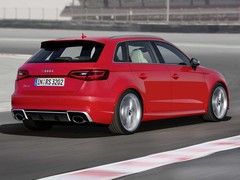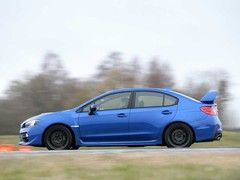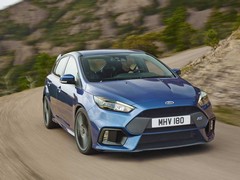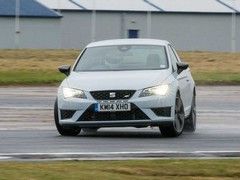Haldex - the truth!
Why on-demand four-wheel drive may not be the demon it's perceived to be

These days, the chances are it'll be a front-drive, transverse engine set-up mated to a Haldex-style coupling to activate the rears. But what are these systems and can they ever replicate the rear-biased machinery of popular legend?
All-wheel drive is everywhere these days. In fact figures from European manufacturers' association ACEA show that last year 12 per cent of all cars sold in the UK came with AWD. That equates to around 300,000 cars and marks a record. Back in 1990 for example just 2.6 per cent of cars were AWD, or 4x4 as it was more properly known back when the majority came with a transfer box.
Of course between now and then we've had the crossover explosion and you already know the bulk of those 300,000 last year were all-wheel drive versions of things the Nissan Qashqai. But there are also and more sporting models with AWD, most recently seen in the 320hp+ Ford Focus RS.
Trending
The trend has not just been with front-drive cars but rear-drivers too, particularly as the torque output has risen higher and higher. "Five years ago makers were saying, this sports car will always be rear-wheel drive only. Now we're talking to all manufacturers about the possible of having their cars AWD," Rob Rickell, president of group technology for GKN Driveline, tells us.
The VW Group has been ploughing this furrow for years using centre Torsen differentials on bigger Audi Quattros and Haldex on-demand couplings for Golf-based cars like the Audi A3. They've even stuck it into a car as small as the Audi A1.
Other suppliers make these electronic front-drive couplings, GKN and JTEKT are two big ones, but Haldex is the best known. Mainly because it was this Swedish company, bought by Borg Warner in 2010, that first perfected the electronic on-demand coupling.
On demand
Its system pushed a percentage of power to the rears when the fronts started to scrabble for grip and was quickly adopted by makers who loved that it didn't require a bulky transfer case and didn't chew through fuel because the majority of the time the rear shafts weren't spinning.
The first two generations from 1998 purely reacted to the slip on the front wheels. Without getting too technical, a Haldex system consists of a hydraulic pump, a clutch and an electronic valve. Early Haldex systems used the difference in speed between two shafts either side (i.e. when there was slip) to activate the pump and connect the rears, while the last three generations from 2004 don't need the slip to activate the pump and so can anticipate when power at the rear is needed.
Most people agree, it's now damn good at what it does. "It's fast, very efficient, very responsive and light, everything the maker wants to have," says Markus Baum, project manager at analysts Roland Berger, a guy whose job it is to assess these systems for finance customers.
The current fifth-gen Haldex can sends about 10-15 per cent of power to the rear in normal driving and more when the fronts slip. How much more is a matter of debate. Not more than 50 per cent is generally agreed, although Ford claims 70 per cent for its new Focus RS (not confirmed as Haldex, but likely). All Haldex will say is that it depends on the customer.
How little can be sent to the rear was highlighted by Swedish magazine Teknikens Varld who stuck a Honda CR-V on a ramp with its front wheels on rollers. It didn't move. Honda changed the software and last year the mag tried again. It didn't move. "As you can see, this is a two-wheel drive car," the presenter says in the video.
Confidence trick
Honda then admitted that its all-wheel drive system (maker unknown) was designed to be "compact, lightweight and fuel-efficient" and then said "if all the available torque required to move the vehicle forward would be transferred to the rear differential then the limit for the torque of the unit would be exceeded".
GKN's Rickell says American and European customers specify more robust systems. But the truth is the car is never going to feel like it's being pushed from the rear. At least not without a bit of help from an active vectoring system.
These have the potential to be the magic ingredient that truly brings enthusiasts like us round to the idea of electronic couplings on all-wheel-drives. The most famous recent convert is the Ford Focus RS, which has GKN's Twinster system coupled to the all-wheel drive set-up. "For what the RS needs to do, this is absolutely going to raise the chinning bar once again on performance," the head of Ford Performance, Dave Pericak, told PistonHeads on its launch.
We had a taste of what's coming while driving a Mini Countryman equipped with the same Twinster system on a recent trip to Arjeplog, northern Sweden. It was hilariously good fun, as much fun as you're likely to have on four wheels. Ford is saying that the RS will come with a 'Drift' button that exploits the torque vectoring's ability to send what rear-directed power there is entirely to one side or the other thanks to its electric clutches.
In the Countryman, drifting was incredibly easy on the iced tracks - not typical a UK surface for sure, but very helpful in comparing a standard all-wheel drive Countryman and a Twinster equipped car. The drifting was easier to instigate and came back into line much more gently. More usefully the Twinster car held around 15mph more speed on a skidpan circle thanks to its ability to 'overspeed' the outer wheel, something that much reduces understeer.
Back to front
Active torque vectoring is becoming more common, even if some makers keep it an option. The new (and very obviously) rear-drive Mercedes-AMG C63 for example has one if you specify the £6,750 S model, while the Golf GTI has Haldex's front-axle VAQ system if you specify the Performance Pack. The Seat Lean Cupra also has it. Haldex itself says this is a "cost-effective and fuel-efficient alternative to all-wheel drive" that might well be favoured by less exotic hot hatches in the future, but there's no doubt the rear-mounted torque vectoring is the one to go for if you're serious about performance.
"If it's front dominant and still understeering, you can get closer to becoming more sporty with the use of torque vectoring," GKN's Rickell says. GKN is working with another manufacturer to put Twinster into a high-performance saloon, possibly a fast Jaguar XE given GKN's relationship with JLR (Twinster is also on the petrol versions of the Range Rover Evoque).
If someone had said 10 years ago that BMW was moving to Haldex to provide an all-wheel drive solution for front-driven cars (as it's doing with the 2 Series Active Tourer) we would have been horrified. But these days the tech has come along so far dynamically and is so good at the dreary but important job of not consuming too much fuel that it's now intriguing more than anything else.
[Sources: Teknikens Vaerld, via YouTube]

You do read positive things about the Golf R/S3 and the like though...I was always told don't believe everything you read and this could be a good example!!



The older systems I've driven have the very annoying feature of not feeding quite enough power rearwards to cure the FWDyness (new word, I like it) of the layout.
I really don't understand all this technology being used to cure the basic fault that the cars should be RWD with a Haldex feeding some power to the front as needed.

You do read positive things about the Golf R/S3 and the like though...I was always told don't believe everything you read and this could be a good example!!

 s off the manufacturers or because they are lazy. You only seem to find out that they actually thought a car was as poor as you did when the replacement comes out and they slag the previous one off before going to say how the new one is a totally different story. Rinse and repeat.
s off the manufacturers or because they are lazy. You only seem to find out that they actually thought a car was as poor as you did when the replacement comes out and they slag the previous one off before going to say how the new one is a totally different story. Rinse and repeat.Clearly he meant that with the front wheels engaged there is no drive to the rear prop shaft not that the rear half shafts/drive shafts (whatever you want to call them) don't spin whilst the car is moving.
I know this is PH so RWD is king and everyone is a at least a semi pro drifter which means anything Haldex gets a hard time but it is a good solution that offers some of the benefits of 4wd with less of the perceived disadvantages at times when having 4wd is not required.
Now that systems can be set up to be more aggressive with preemptive engagement and being able to send substantial amount of the engine's torque to the rear only there should be ways to make these systems feel more RWD. The older systems can be recalibrated by changing the haldex controller but i'm not so clued up on the current generation.

May I suggest that if you are incapable of seeing which parts of an article are from a manufacturer (the clue's in the fact that they're direct quotes) then you should... urm..... just feck off.
Regarding the article, I can vouch for Haldex having improved over the years. My mk1 TT (which I still love and don't care if you think it's a girl's car) has an old Haldex and it's basically front wheel drive until you're already in trouble, athough you can use it to your advantage if the traction control's off. My mk7 Golf R does feel like it's four-wheel drive. The grip's incredible in comparison, although there may be other factors involved.....

Now people will go into their VW garage or Audi garage and hear about the amazing sporty Haldex system, and that is what VAG are selling.
A decent technical appraisal independent of the marketing stuff from the manufacturers would be good.
Dave

there is a controller upgrade for the R32 that transforms it
http://www.awesomegti.com/haldex-gen-2-ecu
Gassing Station | General Gassing | Top of Page | What's New | My Stuff











